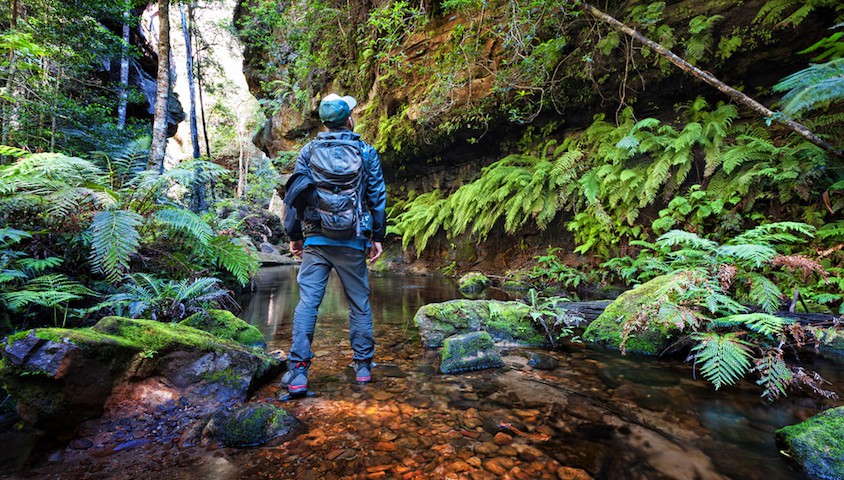With the summer season and Christmas holidays fast approaching people young and old are beginning to look forward to long days of leisure.
The average Wild reader may be lining up an international expedition, or perhaps an intrepid trek interstate. However, you don’t have to be a dyed-in-the-wool adventurer to get active in nature, and if you live in Australia, chances are you won’t have to travel far.
For Sydney’s and the tens of thousands of visitors it can expect this summer, there are more nature experiences available within a few hours drive of the CBD than you can poke a stick at. So, in order to help people whittle down their list of options, we’ve partnered with Expedia.com.au to produce a shortlist of locations that offer wilderness adventure experiences for almost every interest and level of ability, as well as having unique conservation value worth preserving into the future.
1. Gardens of Stone, Blue Mountains
‘The Gardens of Stone, so close to its counterpart, the sparkling urban landscape of Sydney, is a wonderful part of the Australian Bush. Its more spectacular and more accessible than just about any other large tract of bushland, yet its just off the tourist track,’ proclaims the Colong Foundation for Wilderness website. Not far from the historic Blue Mountains town of Lithgow, The Gardens of Stone is a unique landscape of naturally occurring stone pagodas, swamps and Aboriginal rock art. For these reasons the place is championed by local bushwalkers, thrill-seeking climbers and those simply hoping to get a glimpse of the region’s wildlife.
A portion of the Gardens of Stone is currently protected as a National Park, but much of it lies unprotected. Several interest groups are currently working to better protect the area, including the endangered species that reside there, such as the regent honeyeater.
2. Ku-ring-gai Chase National Park, Sydney
In northern Sydney, Ku-ring-gai Chase National Park offers delights for visitors interested in nature experiences within a stone’s throw of the city. With Aboriginal art and cultural appreciation tours, birdwatching, wildlife encounters and much more, this national park is the perfect place to wind down. It’s also the ideal spot to introduce beginners and children to activities like bushwalking, paddling and camping.
3. Gosford, Central Coast
Moving northward, Gosford lies on the NSW coastline and acts as a gateway to the Central Coast. From here, visitors can go explore the Central Coast Reef, survey the Ourimbah State Forest or take in the majestic vistas along the Bouddi Coastal Walk in Bouddi National Park. It’s also just a short distance to Brisbane Waters National Park, where you can cool off after a long bushwalk in the pool below Somersby Falls.
For an experience that’s a little out of the usual, check out TreeTops in Ourimbah State Forest. The adventure park will keep the kids busy for hours, and it’s also been certified as an ecotourism destination for its conservation practices.
4. Royal National Park

A bushwalker crosses a small stream by the beach in Royal National Park, NSW. Photo: Gilbert Romane.
Just 30 kilometres south of Sydney, Royal National Park is significant as the second ever national park to be created, following Yellowstone in the US. It encompasses a wide variety of local ecosystems and provides protection to an even greater number of plant and animal species. Not only can visitors to the park expect to find world class bushwalking, beach walking and swimming holes, there’s even a naturist beach – Werrong – available for the more liberated adventurer.
Regardless of your preference in attire while in the bush, all visitors to Royal National Park should visit the spectacular Eagle Rock and nearby waterfalls that tumble from the sea cliffs at Curracarong.
5. Dalrymple-Hay Nature Reserve
Dalrymple-Hay Nature Reserve may not have the long history or scale of something like Royal National Park, but it has a particular significance for the greater Sydney region. It was first suggested the area should be protected in 1920, and since then it has come to represent one of the last remnants of Blue Gum High Forest that once dominated much of the region. Just one percent of this forest remains, providing shelter to sugar gliders, possums and many native birds.
A short walk through the reserve, Garigal National Park lies on the other side of a few suburban blocks. Sightseeing in this area highlights the ways in which human activity has surreptitously encroached upon native Australian ecosystems since settlement.



